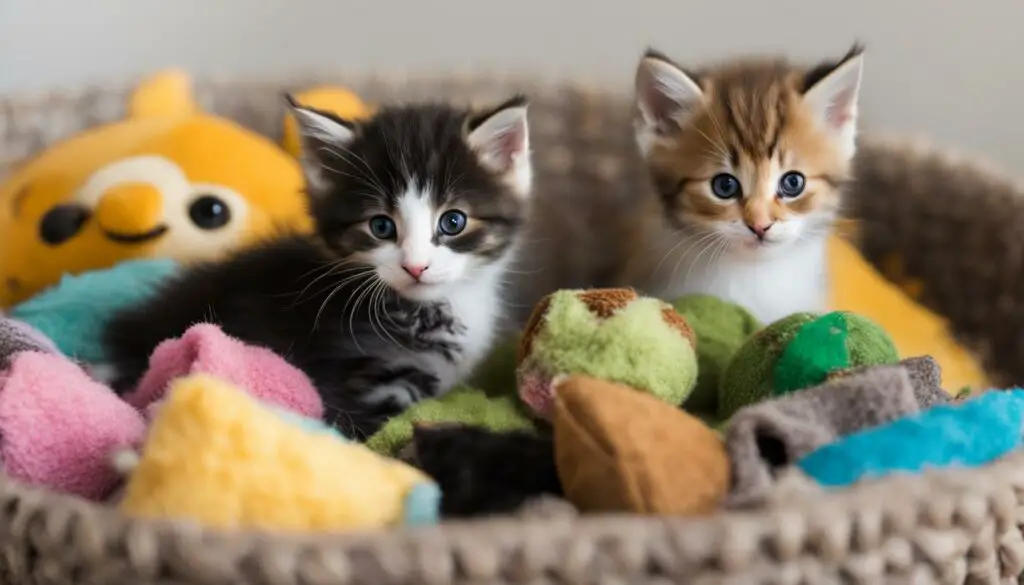Many cat owners are perplexed by the fact that their feline friend seems to harbor a dislike for everyone except for themselves. It can be disheartening and leave you wondering why your cat shows such a preference. In this article, we will explore the reasons behind this behavior and provide valuable insights into your cat’s unique personality and socialization experiences.
Key Takeaways:
- Cats’ early socialization period plays a crucial role in their comfort around strangers.
- Negative experiences can lead to fear-based aggression and a general mistrust of new people.
- Cats’ sensory sensitivity and fear triggers can contribute to their dislike of unfamiliar individuals.
- Creating a safe and secure environment for your cat can help reduce anxiety and aggressive tendencies.
- Understanding your cat’s body language can help you recognize signs of discomfort or overstimulation.
The Importance of Early Socialization
Early socialization plays a crucial role in shaping a cat’s behavior and their response to unfamiliar individuals. During the critical socialization period, which occurs between 3 to 8 weeks of age, kittens are highly receptive to new experiences and interactions. Exposure to various stimuli, including different people, helps them develop positive associations and allows them to feel more at ease around strangers later in life.
Lack of early socialization can lead to fear and anxiety in cats when confronted with unfamiliar individuals. Without positive experiences during this formative period, cats may become increasingly wary and defensive, exhibiting aggressive behavior as a result. This behavior is rooted in their innate self-preservation instincts and their fear response to potential threats.
To help your cat become more comfortable and sociable with others, it is important to provide them with positive socialization experiences early on. This can include gentle handling, exposure to new environments, and interactions with different people. It’s important to note that socialization should be done gradually and at your cat’s own pace, ensuring they feel safe and secure throughout the process.
| Benefits of Early Socialization | Consequences of Lacking Socialization |
|---|---|
| – Increased comfort around unfamiliar individuals | – Fear and aggression towards strangers |
| – Improved ability to adapt to new environments | – Difficulty adjusting to new situations |
| – Enhanced social skills and interactions | – Limited trust and bonding with others |
| – Lowered stress levels and anxiety | – Heightened fear response and defensive behavior |
By focusing on early socialization and providing positive experiences, cat owners can help their feline companions develop a more sociable and confident demeanor when encountering new individuals. This not only enhances their overall well-being but also strengthens the bond between cats and their human caretakers.

The Impact of Negative Experiences on a Cat’s Trust Issues
As a cat owner, it’s essential to understand that negative experiences can greatly influence your feline companion’s perception of unfamiliar individuals, leading to fear-based aggression and trust issues. Cats are highly sensitive animals, and their past interactions with people can shape their behavior and responses.
Just like humans, cats form associations based on their experiences. Positive interactions, such as gentle petting and play, can create a sense of trust and security, while negative encounters, such as rough handling or traumatic incidents, can instill fear and anxiety. These negative experiences can make cats wary and defensive around new people, causing them to display aggressive behaviors as a protective mechanism.
It’s important to remember that a cat’s trust issues are not a reflection of their personality, but rather a result of their past experiences. Building trust requires patience and understanding, as it takes time for a cat to overcome their fear and learn to associate new people with positive experiences. By providing a safe and secure environment and gradually exposing your cat to new individuals in a controlled manner, you can help them overcome their fear and develop healthier relationships.
Table:
| Negative Experiences | Impact on Trust |
|---|---|
| Physical abuse or trauma | Severe fear and aggression towards strangers |
| Loud or chaotic environments | Heightened anxiety and avoidance of new people |
| Unpredictable or aggressive behavior from humans | Increased fear response and defensive aggression |
Understanding and addressing your cat’s trust issues requires a compassionate approach. Avoid forcing your cat into uncomfortable situations and respect their boundaries. Provide them with hiding spots and elevated perches so they can observe and approach new people at their own pace. Consulting with a professional animal behaviorist can also be beneficial in developing strategies to help your cat overcome their fear and build trust in a positive and supportive environment.
Sensory Sensitivity and Fear Triggers
When it comes to understanding feline behavior, it’s important to recognize the role that sensory sensitivity and fear triggers play in how cats interact with strangers. Cats have highly developed senses, including their keen sense of smell and hearing. Strong scents, unfamiliar voices, and sudden movements can all create fear and anxiety in cats, leading to aggressive behavior towards people they don’t know. This instinctual fear response is rooted in their natural survival instincts and their need to protect themselves.
Imagine if you were suddenly confronted with a loud noise or an overpowering scent that you’ve never encountered before. It’s likely that you would feel a sense of unease or even fear. The same principle applies to cats. These fear triggers can quickly put them on high alert and lead to defensive behavior, such as hissing, growling, or even scratching. It’s important to respect their boundaries and understand that their reactions are instinctual, not personal.
Creating a safe and calm environment for your cat can help reduce their anxiety and minimize the likelihood of fear-based aggression. Providing them with hiding spots and vertical spaces where they can retreat to when they feel overwhelmed can be incredibly beneficial. These spaces give them a sense of security and control, allowing them to feel more at ease in their surroundings. Additionally, separating your cat from strangers during social interactions can help them feel more comfortable and reduce their stress levels.
| Common Fear Triggers | How to Minimize Fear Response |
|---|---|
| Loud noises | Provide a quiet, secluded space for your cat to retreat to |
| Strong scents | Avoid using heavily scented cleaning products or perfumes |
| Unfamiliar voices | Encourage visitors to speak softly and avoid sudden changes in tone |
| Sudden movements | Ask visitors to move slowly and avoid making any sudden gestures |
By understanding the role that sensory sensitivity and fear triggers play in your cat’s behavior, you can take steps to create a more comfortable and relaxed environment for them. Remember to be patient and give your cat time to adjust to new people at their own pace. With time, patience, and a little extra care, you can help your cat feel more at ease around strangers and reduce their fear-based aggression.
Managing Your Cat’s Environment
When dealing with cat behavior problems, such as aggression or dislike towards strangers, it’s essential to create a conducive environment that promotes your cat’s well-being and helps alleviate their anxiety. Here are some effective techniques for managing your cat’s environment:
1. Provide Enrichment and Hiding Spots
Cats are territorial animals that require a sense of security in their surroundings. Make sure to provide plenty of hiding spots, such as cat towers, shelves, or enclosed spaces, where your cat can retreat to when they feel overwhelmed or stressed. This allows them to observe their environment from a safe distance and regain their sense of control.
Additionally, offer various forms of enrichment, such as interactive toys, puzzle feeders, and scratching posts, to stimulate their senses and keep them mentally and physically engaged. A stimulated cat is less likely to exhibit aggressive behavior towards visitors.
2. Create Separate Areas for Social Interactions
When visitors come to your home, it’s important to create separate areas for your cat during social interactions. This can be achieved by designating a specific room or using baby gates to create a safe zone where your cat can observe and interact with visitors at their own pace.
By providing your cat with their own space, you allow them to feel in control of their environment and reduce the likelihood of them feeling threatened or displaying aggressive behavior. Make sure to equip the area with their favorite toys, treats, and comfortable bedding to make it a positive and enjoyable space for them.
3. Gradual Exposure and Positive Reinforcement
Socialization plays a crucial role in helping cats overcome fear and aggression towards strangers. Start by gradually exposing your cat to new people in a controlled and positive way. Begin with individuals who are calm and cat-friendly, and gradually increase the exposure over time.
During these interactions, use positive reinforcement techniques, such as treats or playtime, to reward your cat for calm and non-aggressive behavior. This helps them associate the presence of visitors with positive experiences, gradually reducing their fear and discomfort.
Remember, managing your cat’s environment is a process that requires patience and consistency. By providing a safe and secure environment, creating separate areas for social interactions, and gradually exposing your cat to new people, you can help them feel more comfortable and reduce their aggression towards strangers.
| Common Cat Behavior Problems | Socialization Techniques | Cat Territoriality | Feline Companionship |
|---|---|---|---|
| Aggression towards strangers | Gradual exposure to new people | Creating separate areas for social interactions | Providing companionship through play and interaction |
| Anxiety and fear-based aggression | Positive reinforcement and desensitization | Enriching the environment with hiding spots | Promoting bonding with regular grooming and affection |
| Excessive territorial marking | Creating multiple litter box locations | Implementing vertical spaces (cat trees, shelves) | Introducing positive reinforcements (treats, toys) |
Understanding Cat Body Language
When it comes to understanding our feline friends, their body language can provide crucial insights into their behavior and personality. Cats communicate through a variety of subtle cues, and being able to interpret their body language can help us recognize when they are feeling comfortable, anxious, or even on the verge of aggression.
One important aspect of cat body language is their tail movements. A relaxed, gently swaying tail often indicates a content and calm cat, while a puffed-up tail can signal fear or aggression. Similarly, paying attention to their ear positions can give us a clue about their mood. Ears that are forward and slightly turned sideways indicate interest and engagement, while flattened ears suggest fear or agitation.
Pupil dilation is another significant indicator of a cat’s emotional state. Dilated pupils can signal excitement or fear, while constricted pupils may imply aggression or stress. By observing these subtle cues, we can better understand our cats and respond appropriately to their needs and emotions.
Recognizing the Signs
In addition to tail movements, ear positions, and pupil dilation, other body language cues include body posture, vocalizations, and even facial expressions. Understanding these signals can help us determine when our cats are feeling comfortable and content, or when they may be on edge and ready to lash out.
I always pay close attention to my cat’s body language, especially when introducing them to new people. It helps me gauge their level of comfort and intervene if necessary. It’s fascinating how much they communicate through subtle movements and expressions!
Remember, each cat is unique, and their body language may vary slightly. It’s essential to spend time observing and getting to know your own cat’s specific cues and mannerisms. This will enable you to develop a deeper understanding of their needs and emotions, promoting a stronger bond between you and your furry companion.

| Body Language Cue | Meaning |
|---|---|
| Tail held high | Confidence and happiness |
| Tail flicking | Agitation or annoyance |
| Ears forward | Curiosity and attention |
| Ears flattened | Fear or aggression |
| Dilated pupils | Excitement or fear |
| Constricted pupils | Aggression or stress |
Setting Boundaries for Visitors
When it comes to managing your cat’s aggression towards visitors, setting clear boundaries is essential for maintaining a harmonious environment. By communicating your cat’s preferences and educating your guests about feline behavior, you can help create a positive and stress-free experience for everyone involved.
Table 7.1: Tips for Setting Boundaries with Visitors
| Tip | Description |
|---|---|
| Inform guests about your cat’s preferences | Let your visitors know in advance that your cat may be hesitant around new people. Explain any specific triggers or behaviors to watch out for. |
| Advise guests to avoid sudden movements | Encourage your visitors to move slowly and avoid abrupt gestures that may startle or agitate your cat. Smooth, gentle movements can help put your cat at ease. |
| Discourage direct eye contact | Explain to your guests that direct eye contact is seen as a threat in feline language. Suggest that they avoid staring at your cat and instead use soft, blinking eye contact to convey friendliness. |
| Allow your cat to approach visitors on their own terms | Remind your guests not to force interactions with your cat. Instead, let your cat initiate contact and allow them to approach new people at their own pace. |
“Creating a safe and comfortable environment for both your cat and your visitors is crucial in fostering a positive cat-human bond.”
By implementing these strategies, you can help your cat feel more comfortable and in control during interactions with visitors. Remember, it’s important to be patient and consistent, as building trust and reducing feline aggression can take time. If you find that your cat’s aggression persists or worsens, seeking professional help from a feline behaviorist may provide further guidance and support.
Counter Conditioning and Positive Associations
Creating positive associations with new people is key to helping your cat overcome their fear and develop a more positive response. By pairing the presence of visitors with enjoyable activities or treats, you can help your cat associate their arrival with pleasant experiences. This can help to build feline affection and foster animal loyalty.
One effective technique is to engage in a play session with your cat using their favorite toys or treats when visitors are present. This not only distracts your cat from their anxiety, but also creates a positive association between the visitors and the enjoyable activity. Gradually, your cat may begin to associate the presence of new people with excitement and pleasure.
Another strategy is to provide a designated safe space for your cat during social interactions. This can be a separate room or a comfortable hiding spot where your cat can retreat to if they feel overwhelmed. By giving your cat the option to choose when and how to engage with visitors, you are allowing them to feel more in control and reducing their anxiety.

Table: Examples of Positive Associations
| Visitor | Positive Association |
|---|---|
| Family member | Offering a special treat during their visit |
| Friend | Engaging in a play session with their favorite toy |
| Neighbor | Providing a cozy hiding spot when they come over |
“Creating positive associations with new people is a gradual process that requires patience and consistency. By implementing these strategies, you can help your cat develop feline affection and become more comfortable around strangers.”
Remember, every cat is unique, and it may take time for your feline companion to adjust to new people. Consistency is key, so be sure to continue reinforcing positive associations with visitors. With time and understanding, you can help your cat develop more positive social behaviors and strengthen the bond between you, your cat, and others.
Gradual Exposure to New People
When it comes to helping your cat become more comfortable around new people, a gradual approach is key. By exposing them to individuals who are least likely to cause fear or stress, you can slowly desensitize them over time. Start with one person at a time and ensure that each interaction is calm and positive.
During these initial interactions, it’s important to closely monitor your cat’s reactions. Look for signs of discomfort or anxiety, such as flattened ears, a flicking tail, or dilated pupils. If your cat appears stressed, it may be necessary to take a step back and give them more time to adjust before introducing new individuals.
As your cat becomes more comfortable with familiar faces, gradually increase the number and types of visitors. This can help expand their socialization skills and build confidence in different situations. Always prioritize your cat’s well-being and allow them to set the pace of these interactions.
Remember, each cat is unique, and the time it takes for them to adjust to new people can vary. Patience, consistency, and positive reinforcement are key to helping your cat develop trust and overcome their fear-based aggression. Seeking guidance from a professional behaviorist can also provide valuable insights tailored to your cat’s specific needs.
Creating a Positive Experience
When introducing new people to your cat, it’s important to create a positive experience for both parties. Encourage visitors to avoid making sudden movements or loud noises that may startle your cat. Instead, ask them to approach calmly and quietly, allowing your cat to initiate contact if and when they feel comfortable.
You can also use treats or toys to reinforce positive associations with new people. For example, ask visitors to offer your cat a treat or play a gentle game that your cat enjoys. This can help your cat associate the presence of visitors with pleasant experiences and reduce their fear or aggression over time.
By gradually exposing your cat to new people and providing a positive and supportive environment, you can help them overcome their fear and develop better socialization skills. With time and patience, your cat can learn to feel more at ease around unfamiliar individuals and build a stronger bond with you and others.

Respecting Boundaries and Preferences
When it comes to social interactions, every cat has its own unique preferences and boundaries. Respecting these boundaries and allowing our feline friends to approach visitors on their terms is essential for building trust and reducing aggression. By understanding and accommodating their territoriality, pet bonding, and feline loyalty, we can create a harmonious environment that promotes positive interactions.
One way to respect our cat’s boundaries is by providing them with a safe space where they can retreat when they need some alone time. This can be a designated room, a cat tree, or even a cozy hiding spot. Giving them control over their environment helps them feel secure and in control, reducing the likelihood of aggressive behavior towards visitors.
In addition to physical boundaries, it’s important to recognize and respect our cat’s emotional boundaries as well. Some cats may be more inclined to seek out social interactions, while others prefer a more independent lifestyle. By understanding and accepting their unique preferences, we can avoid pushing them out of their comfort zone and foster a better relationship based on trust.
Teaching Visitors Cat-Friendly Behavior
When welcoming visitors into your home, it’s essential to create a cat-friendly environment to ensure the comfort and well-being of your feline companion. By educating your guests about cat-friendly behavior and fostering a positive human-animal connection, you can help alleviate feline fear triggers and promote a harmonious relationship. Here are some tips for teaching visitors how to interact with your cat:
- Avoid direct eye contact: Cats can interpret direct eye contact as a threat, so encourage your guests to avoid staring at your cat. Instead, suggest they practice “eye kisses” – closing their eyes and slowly blinking to communicate non-threatening intentions.
- Use gentle movements: Quick, sudden movements can startle cats and trigger fear-based aggression. Advise your visitors to move slowly and calmly when interacting with your cat, allowing your feline friend to approach them first.
- Respect personal space: Cats are territorial creatures and value their personal space. Teach your guests to give your cat the freedom to approach them at their own comfort level. This will help build trust and reduce stress for both your cat and your visitors.
- Offer treats and rewards: Encourage your guests to give your cat treats or engage in playtime to create positive associations. This will help your cat associate their presence with enjoyable experiences, reinforcing a positive connection.
By following these cat-friendly guidelines, your visitors can contribute to a positive and calming atmosphere for your cat. This will not only help alleviate feline fear triggers but also strengthen the human-animal bond. Remember, patience and understanding are key when introducing your cat to new people, and positive reinforcement will go a long way in creating a harmonious environment.
For a visual representation of these tips, refer to the table below:
| Teaching Visitors Cat-Friendly Behavior | Positive Impact on Cats |
|---|---|
| Avoid direct eye contact | Decreased stress and fear response |
| Use gentle movements | Reduced startle response and fear-based aggression |
| Respect personal space | Enhanced trust and comfort for both cats and visitors |
| Offer treats and rewards | Positive association with visitors and reinforcement of a calm environment |
Remember, cats have unique personalities and may require different approaches when interacting with visitors. Observing their body language and adjusting accordingly will help create a safe and welcoming environment for all. By teaching your visitors cat-friendly behavior, you can foster a positive human-animal connection and ensure that your cat feels more at ease in the presence of others.

Recognizing True Aggression
When it comes to our beloved feline companions, aggression can sometimes be a cause for concern. Understanding whether your cat’s behavior is true aggression or fear-based can help you address the issue effectively.
True aggression in cats is often accompanied by hissing, spitting, defensive posturing, and deep bites. It may occur in response to a perceived threat, territorial disputes, or resource guarding. Fear-based behavior, on the other hand, stems from anxiety and a cat’s instinct to protect itself from potential harm.
Remember, aggression is not always an indication of a bad-tempered cat. It can be a defense mechanism triggered by fear or discomfort.
If your cat displays signs of true aggression, seeking professional help is recommended. A qualified feline behaviorist or animal behavior professional can assess the underlying causes of the aggression and provide personalized advice and strategies for managing the issue. They can guide you through behavior modification techniques and help create a safe and harmonious environment for both you and your cat.
| Signs of True Aggression | Signs of Fear-Based Behavior |
|---|---|
| Hissing | Cowering or hiding |
| Spitting | Excessive grooming |
| Defensive posturing | Unprovoked aggression |
| Deep bites | Freezing or stiff body posture |
By recognizing the signs and understanding the root causes, you can take appropriate measures to address your cat’s aggression and provide them with the support they need to feel safe and secure.

Recognizing True Aggression
Patience and Consistency
In dealing with your cat’s fear-based aggression, it is important to approach the situation with patience and consistency. Every cat is unique, and overcoming their fear and aggression towards others can take time and effort. By providing a stable and predictable environment, using positive reinforcement techniques, and practicing gradual desensitization, you can help your cat gradually reduce their fear and aggression.
Consistency is key in reinforcing positive behaviors and helping your cat feel secure. Stick to a routine that includes regular feeding times, play sessions, and social interactions. Consistent rules and boundaries will help your cat understand what is expected of them and provide a sense of structure and safety.
Creating a calm and peaceful environment for your cat is crucial in managing their fear-based aggression. Minimize exposure to stressful situations and provide plenty of hiding spots and vertical spaces where your cat can retreat if they feel overwhelmed. This will give them a sense of control and allow them to feel safe and secure in their surroundings.
Remember, progress may be slow, but with patience and consistency, you can help your cat overcome their fear-based aggression and create a more harmonious living environment for both of you.

Table: Tips for Managing Fear-Based Aggression in Cats
| Tip | Description |
|---|---|
| Provide a safe space | Create hiding spots and vertical spaces where your cat can retreat if they feel overwhelmed. |
| Stick to a routine | Establish consistent feeding times, play sessions, and social interactions to provide structure and security. |
| Use positive reinforcement | Reward your cat with treats and praise for calm, non-aggressive behavior. |
| Practice gradual desensitization | Expose your cat to gradually increasing levels of stimuli over time, rewarding them for staying calm. |
| Seek professional help if needed | If your cat’s aggression persists or escalates, consult a qualified feline behaviorist for personalized guidance. |
Seeking Professional Help
If your cat’s fear-based aggression persists or escalates despite your best efforts, it may be time to seek professional help. A feline behaviorist or animal behavior professional can provide invaluable guidance and expertise in understanding and addressing your cat’s specific needs. They have in-depth knowledge of pet psychology, human attachment, animal behavior patterns, and feline fear triggers.
Professional help can make a significant difference in managing your cat’s aggression and creating a harmonious environment for both you and your feline companion. These experts can assess your cat’s behavior, identify the underlying causes of aggression, and develop a personalized behavior modification plan. They can guide you through the process, providing step-by-step instructions, and offering ongoing support and advice.
“Seeking professional help for your cat’s fear-based aggression is a proactive step towards creating a safe and comfortable environment for your furry friend. Behavior professionals can provide valuable insights and practical strategies that are tailored to your cat’s unique needs. Don’t hesitate to reach out for assistance – helping your cat live a happier, stress-free life is worth it.”
Benefits of Professional Guidance
Working with a professional can help you navigate the complexities of feline behavior and develop a deeper understanding of your cat’s needs. They can help you identify triggers for aggression, implement behavior modification techniques, and create a structured environment that promotes positive outcomes. By addressing the root causes of your cat’s fear and anxiety, you can improve their overall well-being and strengthen your bond with them.
| Benefits of Seeking Professional Help for Your Cat’s Aggression |
|---|
| Expert knowledge of feline behavior and psychology |
| Customized behavior modification plan |
| Step-by-step guidance and ongoing support |
| Identification of underlying causes of aggression |
| Improved understanding of your cat’s needs |
| Development of a harmonious environment |
| Enhanced bond between you and your cat |
Remember, each cat is unique, and what works for one may not work for another. Seeking professional help can provide a tailored approach to managing your cat’s aggression, ensuring the best possible outcomes for both you and your feline friend.

Conclusion
Understanding your cat’s preferences, instincts, and feline psychology is key to resolving their dislike of others. By implementing strategies tailored to their unique needs, you can create a harmonious environment where your cat feels safe and comfortable with everyone, not just with you.
Patience and consistency are crucial when dealing with fear-based aggression. Providing a stable and predictable environment, using positive reinforcement, and practicing desensitization techniques can gradually reduce your cat’s fear and aggression towards unfamiliar individuals.
If your cat’s behavior persists or worsens, seeking guidance from a qualified feline behaviorist or animal behavior professional is recommended. They can provide personalized advice and strategies to address your cat’s specific needs and help strengthen the bond between you and your beloved feline companion.
Remember, understanding your cat’s unique personality and experiences is the first step towards creating a positive and enriched life for them. With dedication and professional help, you can help your cat overcome their fear and build a trusting relationship with others.
FAQ
Why does my cat hate everyone but me?
Many cats may show a preference for their owners due to their unique personality and socialization experiences. Understanding the reasons behind this behavior can provide valuable insights into your cat’s preferences and help you build a stronger bond with them.
When is the critical socialization period for kittens?
The critical socialization period for kittens is between 3 to 8 weeks of age. During this time, exposing them to new experiences and interactions can help them become comfortable around unfamiliar people.
Can lack of early socialization make cats dislike strangers?
Yes, lack of early socialization can make cats fearful of new individuals, leading to their dislike or aggression towards strangers. Kittens who have not been exposed to various people and experiences during this critical period may be more prone to fear-based behavior.
How do past experiences with people influence a cat’s perception of strangers?
Cats’ past experiences with people can greatly influence their perception of unfamiliar individuals. Positive interactions can create a positive association, while negative experiences can lead to fear-based aggression and a general mistrust of new people.
What sensory triggers can cause fear and aggression in cats?
Cats have highly developed senses, including a keen sense of smell and hearing. Strong scents, unfamiliar voices, and sudden movements can trigger fear and anxiety in cats, causing them to exhibit aggressive behavior towards strangers.
How can I create a safe and secure environment for my cat?
Creating a safe and secure environment for your cat is crucial. Providing hiding spots, vertical spaces, and separate areas for your cat during social interactions can help reduce their anxiety and aggressive tendencies.
How can I interpret my cat’s body language to understand their discomfort?
Learning to interpret your cat’s body language can help you recognize subtle signs of discomfort or overstimulation. Tail movements, ear positions, and pupil dilation can indicate when your cat is reaching their threshold and may lash out.
What should I communicate to visitors about interacting with my cat?
It’s important to communicate with your visitors and set boundaries for interactions with your cat. Educate them about your cat’s preferences and advise them to avoid sudden movements and direct eye contact to prevent triggering fear-based aggression.
How can I help my cat develop a more positive response to new people?
Creating positive associations with new people can help your cat overcome their fear and develop a more positive response. Pairing the presence of visitors with enjoyable activities or treats can help your cat associate their arrival with pleasant experiences.
How can I gradually expose my cat to new people?
Gradually exposing your cat to new people, starting with individuals who are least likely to cause fear or stress, can help desensitize them over time. Slowly increasing the number and types of visitors while closely monitoring your cat’s reactions is key.
How can I respect my cat’s boundaries and preferences?
Each cat has unique preferences and boundaries when it comes to social interactions. Respecting your cat’s need for personal space and allowing them to approach visitors on their own terms can help build trust and reduce aggression.
How can I teach visitors cat-friendly behavior?
Educating your visitors about cat-friendly behavior, such as avoiding direct eye contact and using gentle movements, can help create a more positive atmosphere for your cat. Teaching them to throw “eye kisses” and communicate non-threatening body language can help put your cat at ease.
How can I differentiate between true aggression and fear-based behavior in cats?
Signs of aggression include hissing, spitting, defensive posturing, and deep bites. Understanding the underlying causes of aggression and seeking professional advice is crucial for managing and addressing the issue.
What should I do if my cat’s fear-based aggression persists?
Dealing with your cat’s fear-based aggression requires patience and consistency. Providing a stable and predictable environment, using positive reinforcement, and practicing desensitization techniques can help gradually reduce their fear and aggression towards others. If the problem persists or escalates, it may be necessary to seek guidance from a qualified feline behaviorist or animal behavior professional.
How can I improve my cat’s behavior and strengthen our bond?
Understanding the reasons behind your cat’s dislike of others and implementing appropriate strategies can help improve their behavior and strengthen the bond between you and your beloved feline companion. With patience, consistency, and professional guidance, you can create a harmonious environment where your cat feels safe and comfortable with everyone, not just you.
Source Links
- https://be.chewy.com/help-my-cat-hates-visitors/
- https://www.reddit.com/r/relationships/comments/qohdda/my_cat_suddenly_hates_my_boyfriend/
- https://vethelpdirect.com/vetblog/2020/07/09/why-does-my-cat-bite-me-unprovoked/








